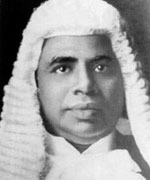Building a local technological capability

In January 1996 the science journal Nature published a report from
Gill Juleff, a British Archaeologist, that wind-driven blast furnaces
had been used for smelting steel in the Samanalawewa area in the first
millennium.
This technology produced, on a large-scale, high-grade steel-which
may have been the famed sword-making material referred to in Arabic
sources as ‘Sarandibi steel’.
There is no evidence of these furnaces after the 11th century. And
there is no continuity between this technology and the later,
village-based steel making techniques, relying on bellows, reported by
Ananda Coomaraswamy in the 20th century.
The discontinuation of this technology coincides with the period in
which the Anuradhapura kingdom collapsed. It was the period of Chola
invasions, of wars and uncertainty and technological and cultural
degradation.
 |
 |
| Sir Cyril
de Zoysa |
AYS Gnanam |
This example from our history illustrates how fragile technological
knowledge is and, once lost, how hard to resurrect.
Learning process
In modern IT parlance, technology is not just about hardware; there
is an incredible amount of software (human knowledge and experience)
associated with it. And it does not exist in a vacuum: it must be backed
by a society and economy that nurtures it.
After 1956, there was a period in which the technological
capabilities of this country advanced rapidly, driven by the needs of
import-substitution industrialisation. Much of this technology was
brought from abroad, but was adapted to Sri Lanka’s requirements and
capabilities.
In many instances, the existing technology was being replaced by a
new one, which meant that we had to start the learning process again.
For example, the Ceylon Government Railways already had the capability
to build steam locomotives.
However, the dieselisation of the 1960s put an end to steam
locomotives. The CGR nevertheless began the laborious climb to
technological self-sufficiency by building diesel-powered shunting
locomotives.
Building and construction sector
Nowhere was this process more apparent than in the building and
construction sector. Led by the innovative ANS Kularatne, modern
construction techniques were introduced and local capabilities were
enhanced. Buildings were mass-produced for the first time.
AYS Gnanam was an industrialist who thrived on import-substitution
industrialisation, branching out from hardware to textiles, plastics and
electronics. A showcase of technological capability building was his
manufacture of radios.
His company had the local agency for a Japanese brand and he began by
assembling radios supplied by his principals. Thereafter, local parts
were substituted one by one until it was ultimately almost a totally
locally-made product. The same process was followed by the Ceylon
Transport Board as it strove to indigenise bus production. Bus body
building was already established by the time the CTB was formed, but now
it was done using mass-production techniques.
The CTB began assembling buses, followed by the substitution of
parts, some being made in-house, others obtained from local
manufacturers. Machinery was obtained for building chassis and the first
Sri Lankan - made bus rolled out in the mid-70s.
Automotive battery production
Sir Cyril de Zoysa was the driving force behind indigenous automotive
battery production. When the market was found to be too small to support
a lead re-processing plant, he joined with the government and the other
manufacturers to establish one for the entire industry.
However, technology transfer is not sufficient. A self-reliant
technological sector requires technological innovation. And that too was
available in abundance.
Technological development
A stunning example of this was in the tea machinery industry, which
was a world leader at the time. In 1966, the Colombo Commercial Company
took out a worldwide patent on fluidised bed tea driers. This was
possible because of the close relationship between the tea machinery
industry and the tea plantation industry.
Another remarkable innovation was by the pioneering Prof JCV
Chinnappa, who developed solar-powered refrigeration. However, although
we had a fairly developed refrigeration industry, the necessary
symbiosis was not there (and perhaps Chinappa was too far ahead of his
time), and Sri Lanka lost its lead.
By the end of the 1970s, Sri Lanka had a solid basis for
technological development. It had a thriving tea machinery industry,
which exported all over the world, the flagship of an industrial sector
which was self-reliant and technologically capable.
Unfortunately, in the post-1977 period the economy was opened up too
rapidly and foreign imports flooded our market.
The economy grew, but at the cost of our technological capacity the
indigenous electronics and tea machinery industries died. The transport
sector became almost totally dependent on foreign imports of rolling
stock and fully-built buses.
Worse, we now no longer have the social and economic basis for
technological innovation. Research and Development budgets are well-nigh
non-existent.
The personnel are there, in the universities and in the technical
colleges.
However, there is nearly nowhere on this island where they can
enhance their technological skills - the atmosphere simply does not
exist. Most of the technologists coming out of institutions of higher
learning drift abroad.
Many educated people are absorbed into the growing outsourcing
sector. But this, like the garment industry, is based upon cheap labour
and our comparative advantage will dissipate as our per capita income
grows.
There are several promising government programmes designed to take
technology to the villages, for example via ‘Nenasela’ IT nodes and
‘Vidatha’ science and technology centres. However, more is required - we
need to change the structure of our economy to accommodate technological
innovation.
Political leaders
If we are to advance into the 21st century, it is imperative that we
build up our technological capabilities. We could learn from other
countries which managed to do so while at the same time keeping their
markets open.
We could also learn from our own building and construction sector,
which has been one of the few to enhance its technological competence in
recent times.
There are also several small companies which have created
technology-based niches for themselves, and this is possibly the way
forward - finding our technological niches and filling them.
What we require from our political leaders is the will to create the
economic, social and cultural conditions which will enable technological
innovation to take systemic root in our country once again.
|



